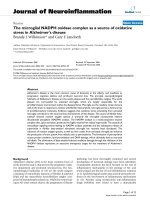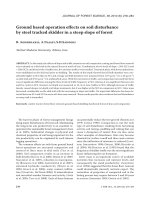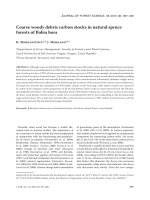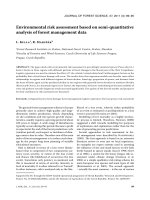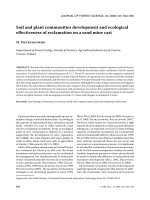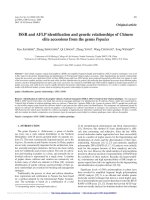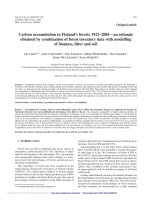Báo cáo lâm nghiệp: "Carbon partitioning: fructose 2,6-bisphosphate content as an indicator of specific changes in carbohydrate metabolism in needles from class II spruce trees" pot
Bạn đang xem bản rút gọn của tài liệu. Xem và tải ngay bản đầy đủ của tài liệu tại đây (198.83 KB, 5 trang )
Carbon
partitioning:
fructose
2,6-bisphosphate
content
as
an
indicator
of
specific
changes
in
carbohydrate
metabolism
in
needles
from
class
II
spruce
trees
W.
Einig
R. Hampp
Universitit
Tubingen,
Biochemie
der
Pflanzen,
Auf
der
Morgenstelle
1,
D-7400
Tobingen,
F.R.G.
Introduction
It
has
been
shown
that
very
low
doses
of
airborne
pollutants
(ozone,
sulfite)
can
significantly
change
source-sink
relation-
ships.
These
shifts
in
allocation
or
trans-
portation
out
of
leaves
can
occur
prior
to
reductions
in
photosynthesis
(ozone;
Mcl_aughlin
and
McConathy,
1983)
and
can
take
place
within
minutes
(Minchin
and Gould,
1986).
In
spite
of
intense
research
in
this
area,
there
is,
however,
only
little
information
available
about
metabolic
acclimation
of
tissues
to
pollutants.
It
has
thus
been
our
aim
to
screen
for
biochemical
indications
of
altered
patterns
of
carbon
allocation
in
needles
of
Norway
spruce
(Picea
abies).
Materials
and
Methods
The
materials
used
for
our
investigations
were
needles
from
spruce
trees
from
2
locations
in
the
southern
part
of
the
Black
Forest
(Kalbele-
scheuer
and
Haldenhof,
near
Freiburg,
F.R.G.).
Collection
and
freeze-drying
of
needle
samples
as
well
as
metatrolite
analyses
were
as
descri-
bed
elsewhere
(Einig
and
Hampp,
1988;
Hampp etaL,
1989).
Results
and
Discussion
Season-
and
age-dependent
variations
in
pool
sizes
There
is
considerable
evidence
that
the
rate
of
starch
synthesis
is
controlled
by
the
rates
of
sucrose
formation
and
trans-
port.
Metabolites
involved
in
the
regulation
of
carbon
partitioning
between
starch
and
sucrose
are
triose
phosphates
(TP;
dihy-
droxyacetone
phosphate,
glyceraldehyde
3-phosphate),
glyceric
acid
3-phosphate
(PGA),
fructose
6-phosphate
(F6P),
ortho-
phosphate
(P
i)
and
pyrophosphate
(PP
i
).
Levels
of
these
metabolites
control
syn-
thesis
and
degradation
of
the
most
impor-
tant
regulator,
fructose
2,6-bisphosphate
(F26BP).
This
compound
affects
cytosolic
sucrose
synthesis
by
inhibiting
the
fruc-
tose
bisphosphatase
(FBPase)
reaction
(gluconeogenesis)
and
activating
a
PP
i-
dependent
phosphofructokinase
(PFP;
ac-
tive
in
both
directions,
glycolysis
and
glu-
coneogenesis
(for
a
review
see
Stitt,
1987;
compare
also
Fig.
1
).
Sucrose
and
starch
as
’endpoints’
of
this
regulatory
system
show
distinct
dif-
ferences
in
their
pool
sizes.
Needles
from
control
trees
have
optimum
starch
levels
in
early
summer
(Fig.
2a).
Independent
of
needle
age,
there
is
a
continuous
decline
towards
October.
Sucrose,
in
contrast,
is
much
more
constant
in
its
seasonal
pool
sizes
(Fig.
2b).
There
are,
however,
specific
differences,
when
pool
sizes
of
phosphorylated
inter-
mediates
are
compared.
An
intimate
cor-
relation
between
pool
sizes
of
TP,
F6P
and
F26BP
is
observed
when
the
average
contents
of
all
needles
(1980-1985)
are
plotted
versus
the
sampling
date
(Fig.
3).
Under
the
assumption
that
the
changes
in
pool
sizes
observed
for
F6P
and
TP
also
occur
in
the
cytosol
of
our
needle
mesophyll
cells,
all
these
observations
can
easily
be
explained
by
the
scheme
shown
in
Fig.
1.
In
June
samples,
e.g.,
starch,
F6P
and
F26BP
are
high,
while
TP
are
low;
high
levels
of
F6P,
possibly
indi-
cative
of
limited
sucrose
export
(rates
of
synthesis
exceed
rates
of
export),
activate
F26BP
synthesis.
Increased
levels
of
F26BP,
however,
favor
glycolysis
over
glu-
coneogenesis
and
thus
TP
are
diverted
into
starch
synthesis.
In
July,
in
contrast,
an
opposite
situation
emerges
with
decreased
amounts
of
F6P
and
F26BP
and
high
levels
of
TP.
This
metabolic
situation
should
thus
be
indicative
of
partitioning
of
carbon
into
sucrose
(starch
decreases)
and
this
situa-
tion
is
obviously
continued
during
summer.
Class
li-specific
changes
in
pool
sizes
There
are
also
significant
differences
when
the
metabolite
pools
are
compared
with
respect
to
needle
loss
(Table
I).
The
average
metabolite
contents
of
NS
needles
from
class
0
and
class
II
trees
(1980-1983;
based
on
dry
weight)
differ
significantly
in
the
levels
of
starch,
TP
and
F26BP,
in
that
class
II
needles
show
a
decrease
in
starch,
compared
to
in-
creased
amounts
of
TP
and
F26BP.
In
contrast,
sucrose,
glucose,
fructose,
PGA
and
F6P
only
show
minor
differences.
Compared
to
the
observations
reported
for
control
needles
above,
the
situation
in
class
II
needles
is
less
straightforward
to
interpret.
The
most
interesting
change
in
concen-
tration
is
shown
by
F26BP.
The
significant-
ly
increased
amount
of
this
regulator
will
surely
inhibit
cytosolic
FBPase
and
will
thus
largely
reduce
carbon
flow
towards
sucrose
(compare
Fig.
1
The
elevated
level
of
F6P,
if
cytosolic,
could
be
respon-
sible
for
this
increase
in
F26BF
Conclusion
Needles
from
declining
trees
exhibit
a
significant
increase
of
F26BP.
This
can
be
taken
as
evidence
for
impaired
sucrose
export.
As
such,
a
metabolic
response
towards
altered
carbon
partitioning
be-
tween
starch
and
sucrose
will
precede
any
visible
signs
of
damage.
The
determina-
tion
of
F26BP
levels
in
needles
could
constitute
an
early
indicator
of
affected
carbon
allocation.
Acknowledgments
Help
in
sample
aquisition,
preparation
for
analy-
sis
and
metabolite
determination
by
L.
Diener,
B.
Egger,
R.
Keil,
J.P.
Schnitzler
and
P.
Weid-
mann
is
gratefully
acknowledged.
This
investi-
gation
was
financed
by
grants
from
the
’Project
Europaisches
Forschungszentrum
fur
Mass-
nahmen
zur
Luftreinhaltung’
(PEF;
84/043/1A,
86/018/1A
(R.H.)).
References
Einig
W.
&
Hampp
R.
(1988)
Der
fructose
2,6-
bisphosphat
gehalt
als
indikator
spezifischer
veranderungen
im
kohlenhydratstoffwechsel
geschadigter
fichtennadeln.
KfK-PEF
35,
Kern-
forschungszentrum
Karlsruhe
Ber.
163-171
1
Hampp
R.,
Einig
W.,
Keil
R.
&
Fink
S.
(1989)
Energy
status
and
carbon
partitioning
in
spruce:
specific
changes
in
relation
to
needle
age
and
degree
of
needle
loss.
In:
International
Sympo-
sium
on
Plants
and
Pollutants
in
Developed
and
Developing
Countries.
(Öztürk
M.,
ed.),
Izmir,
Turkey,
pp.
487-508
McLaughlin
S.B.
&
McConathy
R.K.
(1983)
Effects
of
S0
2
and
03
on
allocation
of
14C-
labeled
photosynthate
in
Phaseolus
vulgaris.
Plant Physiol.
73,
630-635
Minchin
P.E.H.
&
Gould
R.
(1986)
Effects of
S0
2
on
phloem
loading.
Plant Sci.
43, 179-183
Stitt
M.
(1987)
Fructose
2,6-bisphosphate
and
plant
carbohydrate
metabolism.
Plant
Physiol.
84, 201-204
